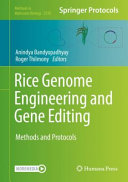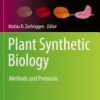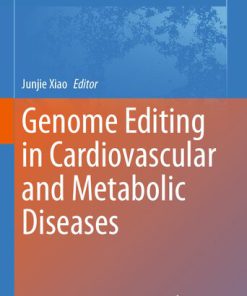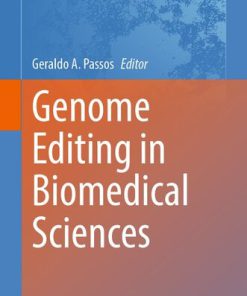Rice Genome Engineering and Gene Editing 1st Edition by Anindya Bandyopadhyay, Roger Thilmony ISBN 9781071610688
$50.00 Original price was: $50.00.$25.00Current price is: $25.00.
Rice Genome Engineering and Gene Editing 1st Edition by Anindya Bandyopadhyay, Roger Thilmony – Ebook PDF Instant Download/Delivery: 9781071610688
Full download Rice Genome Engineering and Gene Editing 1st Edition after payment

Product details:
ISBN 10:
ISBN 13: 9781071610688
Author: Anindya Bandyopadhyay, Roger Thilmony
Rice Genome Engineering and Gene Editing 1st Edition Table of contents:
Part I: Genetic Engineering and Tissue Culture of Rice
Chapter 1: Gene Assembly in Agrobacterium via Nucleic Acid Transfer Using Recombinase Technology (GAANTRY)
1 Introduction
2 Materials
2.1 The GAANTRY System
2.2 Growth Medium, Culture Conditions, and Equipment
3 Methods
3.1 Preparation of Donor and Helper Plasmids
3.2 Preparation of the Electrocompetent ArPORT1 Recipient Strain
3.3 Loading B Donor Cargo into the ArPORT1 Strain
3.4 Loading P Donor Cargo into the ArPORT1 Strain
3.5 Quick Genomic DNA Extraction for ArPORT1 Colonies
3.6 Genomic PCR Validation of GAANTRY Assemblies
3.7 Generation of Transgenic Plants
4 Notes
References
Chapter 2: TransGene Stacking II Vector System for Plant Metabolic Engineering and Synthetic Biology
1 Introduction
2 Materials
2.1 General Molecular Biology Reagents
2.2 Microbial Strains
2.3 Vector Plasmids
3 Methods
3.1 Propagation of Acceptor Vectors (See Note 1)
3.2 Propagation of Donor Vectors
3.3 Propagation of Marker/Marker Excision Donor Vectors (See Note 5)
3.4 Subcloning Target Genes into the Donor Vectors
3.5 The First Round of Gene Assembly (Round I)
3.6 The Second Round of Gene Assembly (Round II)
3.7 More Round of Assembly Cycles
3.8 Marker/Marker Excision Cassette Assembly
3.9 Analysis of Structural Stability of Multigene Constructs in A. tumefaciens
3.10 Fast Test of Marker Deletion in E. coli NS3529
3.11 Analysis of Marker Deletion in Transgenic Plants (See Note 14)
4 Notes
References
Chapter 3: Morphogenic Regulators and Their Application in Improving Plant Transformation
1 Introduction
2 Regulation of Morphogenesis
3 Genes Involved in In Vitro Somatic Embryogenesis
3.1 Baby Boom (BBM) and BBM-like (BBML) Genes
3.2 Wuschl (WUS) and WUS Homeobox (WOX) Genes
3.3 MYB118 and MYB115
3.4 LEC and Related Genes
3.5 AGAMOUS-like 15 (AGL15) and AGL18
3.6 Somatic Embryo-Related Factor 1 (SERF1)
4 Epigenetic Regulation of Somatic Embryogenesis
5 Application of Morphogenic Regulator Genes in Plant Transformation
6 Perspectives
References
Chapter 4: A Rapid Method for Stably Transforming Rice Seeds
1 Introduction
2 Materials
2.1 For Agrobacterium Transformation
2.2 For Plant Screening and Selection
3 Methods
3.1 Agrobacterium Transformation and Culture
3.2 Preparation of Plant Material
3.3 Transformation of Rice Seeds
3.4 Screening for Stable Transgenics
4 Notes
References
Chapter 5: Agrobacterium tumefaciens-Mediated Transformation of Rice by Hygromycin Phosphotransferase (hptII) Gene Containing …
1 Introduction
2 Materials
2.1 Agrobacterium Cells Harboring CRISPR/Cas9 Vector
2.2 Rice Seeds
2.3 Seed Sterilizing Solution
2.4 Media, Antibiotics, and Plant Growth Hormones
2.5 Culture Room and Greenhouse
3 Methods
3.1 Confirmation of CRISPR/Cas9 Vector
3.2 Preparation of Agrobacterium Culture (Prepare 2 Days Prior to Infiltration Date)
3.3 Preparation of Explant-Embryogenic Calli
3.4 Transformation
3.5 Washing to Eradicate Agrobacterium Overgrowth
3.6 Selection of Positive Calli
3.7 Plant Hardening in Culture Room
3.8 Management of Regenerants in Greenhouse
3.9 In Vitro Germination Test of T1 Seeds
4 Notes
References
Chapter 6: Genotype-Independent Regeneration and Transformation Protocol for Rice Cultivars
1 Introduction
2 Materials
2.1 Surface Sterilization of Explants
2.2 Embryogenic Callus Induction Medium
2.3 Shoot Regeneration Medium
2.4 Root Induction Medium
2.5 Luria Bertani Broth Medium
2.6 Partial Desiccation Treatment
2.7 Biolistic-Mediated Transformation
2.8 Plant Genomic DNA Isolation
2.9 PCR (Polymerase Chain Reaction) and Sequencing
2.10 Southern Blot Analysis
3 Methods
3.1 Seed Selection
3.2 Explant Preparation
3.3 Induction of Embryogenic Callus
3.4 Partial Desiccation Treatment
3.5 Biolistic-Mediated Transformation
3.5.1 Preparation of Gold Particle Suspension
3.5.2 Coating of DNA on Gold Particles
3.5.3 Arrangement of Calli for Bombardment
3.5.4 Bombardment Instrumentation
3.6 Regeneration of Plantlets from Bombarded Calli
3.7 Acclimatization and Field Establishment
3.8 Molecular Validation
3.8.1 PCR Analysis
3.8.2 Sanger DNA Sequencing
3.8.3 Southern Blot Analysis
4 Notes
References
Part II: Genome Editing and Targeted Integration in Rice
Chapter 7: Rapid Vector Construction and Assessment of BE3 and Target-AID C to T Base Editing Systems in Rice Protoplasts
1 Introduction
2 Materials
2.1 Plant
2.2 Bacterial Strain and Growth Medium
2.3 Target Sequences, gRNA, and Plasmids
2.4 Equipment
2.5 Reagents and Solutions
3 Methods
3.1 T-DNA Vector Construction for BE3 and Target-AID Systems
3.2 Assessment of Base Editing Efficiency for BE3 and Target-AID Systems Using a Rice Protoplast Transient Expression System
4 Notes
References
Chapter 8: Genome Editing of Rice by CRISPR-Cas: End-to-End Pipeline for Crop Improvement
1 Introduction
2 Materials
2.1 Bacterial Strains
2.2 Bacterial Culture Media
2.3 Cloning Reagents and Kits
2.4 Osmoticum Medium
2.5 Regeneration Media
2.6 Rooting Media
3 Methods
3.1 Editing Strategy and Guide Design
3.2 Vector Construction
3.3 Plant Transformation
3.3.1 Isolation of Immature Embryos for Transformation
3.3.2 Preparation of Scutellum-Derived Callus
3.3.3 Transformation by Particle Gun Method
3.3.4 Transformation by Agrobacterium Method
3.3.5 Transformation Using Riboprotein Complex of Cas9 Protein-gRNA Transcript
3.4 Molecular Analysis of Genome Edited Lines
3.5 Phenotyping of Genome Edited Line
3.6 Discussion
References
Chapter 9: Single Base Editing Using Cytidine Deaminase to Change Grain Size and Seed Coat Color in Rice
1 Introduction
2 Materials
2.1 Generation of the pCambia-CRISPR-BE Backbone Vector
2.2 Isolation of Rice Protoplasts
2.3 Transient Expression in Rice Protoplasts
2.4 Rice Transformation
2.5 Screening and Verification
3 Methods
3.1 Generation of the pCambia-CRISPR-BE Backbone Vector
3.2 Generation of Working Vector
3.2.1 pCambia-CRISPR-BE-SMG11 Cloning
3.2.2 pCambia-CRISPR-BE-Osfbx310 Cloning
3.3 Isolation of Rice Protoplasts and Transient Expression
3.4 Rice Transformation
3.5 Screening and Verification of Success of Editing
4 Notes
References
Chapter 10: Analysis of Off-Target Mutations in CRISPR-Edited Rice Plants Using Whole-Genome Sequencing
1 Introduction
2 Materials
2.1 Anaconda3 Distribution
2.2 Whole-Genome Sequencing (WGS) Data
2.3 Reference Genome
2.4 Known SNP and Indel Database
2.5 Software and Tools
2.5.1 FastQC Software
2.5.2 SKEWER Software
2.5.3 BWA Software
2.5.4 SAMtools
2.5.5 Picard Tools
2.5.6 Genome Analysis Toolkit
2.5.7 LoFreq* Software
2.5.8 MuTect2 Software
2.5.9 VarScan2 Software
2.5.10 Pindel Software
2.5.11 BEDTools
2.5.12 Cas-OFFinder Software
3 Methods and Results
3.1 Run FastQC for Quality Control
3.2 Run SKEWER to Remove Adapters
3.3 Run GATK Best Practices
3.3.1 Map Reads to Rice Reference Genome Using BWA
3.3.2 Mark Over-sequenced Reads as Duplicate Using Picard
3.3.3 Indel Realignment Using GATK
3.3.4 Base Recalibration Using GATK
3.4 Run LoFreq*
3.5 Run MuTect2
3.6 Run VarScan2
3.7 Run Pindel
3.8 Run BEDTools to Filter Mutations
3.9 Run Cas-OFFinder for In Silico Off-Target Detection
3.10 Results
3.10.1 Count SNVs and Indels of Each Sample
3.10.2 Visualization and Validation of On-Target Sites
3.10.3 Find Off-Target Sites and Visualize the Sites
4 Notes
References
Chapter 11: Efficient Genome Editing in Rice Protoplasts Using CRISPR/CAS9 Construct
1 Introduction
2 Materials
2.1 Mix for Digestion/Ligation and CRISPR Vector Construction
2.2 Solutions for Protoplast Digestion and Purification
2.3 Solutions for Protoplast Transformation
3 Methods
3.1 sgRNA Design (See Note 1)
3.2 Cloning in pDest Vector
3.2.1 Annealing Oligonucleotides
3.2.2 Digestion/Ligation in the pOs-sgRNA ENTRY Vector (Fig. 2)
3.2.3 Transformation in DH5alpha
3.2.4 Subcloning in Vector pOs-CAS9 hpt ccdB-2.0
3.3 Plant Growth for Protoplast Preparation (See Note 5)
3.4 Protoplast Extraction (See Note 6)
3.5 Protoplast Purification (See Note 7)
3.6 Protoplast Transformation (See Note 8)
3.7 DNA Extraction
3.8 Mutation Analysis (See Note 10)
4 Notes
References
Chapter 12: Single Transcript Unit CRISPR 2.0 Systems for Genome Editing in Rice
1 Introduction
2 Materials
2.1 Bacterial Strains
2.2 Vectors
2.3 Reagents
2.4 Equipment
3 Methods
3.1 Design sgRNA/crRNA for Targeted Mutagenesis
3.2 Vector Construction for Single Site Genome Editing (Fig. 1)
3.3 Vector Construction for Multiplex Genome Editing with STU-Cas9 System
3.4 Vector Construction for Multiplex Genome Editing with STU-Cas12a System (Fig. 3)
4 Notes
References
Chapter 13: Improving a Quantitative Trait in Rice by Multigene Editing with CRISPR-Cas9
1 Introduction
2 Materials
3 Methods
3.1 Vector Construction
3.2 Designing sgRNA of Target Genes
3.3 Fragment Amplification
3.3.1 Fragment Amplification
3.3.2 Fragment Amplification
3.3.3 Fragment Amplification
3.3.4 Fragment Amplification
3.3.5 The First Fusion PCR
3.3.6 The Second Fusion PCR
3.3.7 The Third Fusion PCR
3.4 Golden Gate Assembly
3.5 Transformation into Competent E. coli DH5α Strain
3.6 Agrobacterium-Mediated Genetic Transformation of Rice
3.7 Mutant Material Identification
3.7.1 DNA Extraction
3.7.2 SSCP Analysis
4 Notes
References
Chapter 14: Rice Haploid Inducer Development by Genome Editing
1 Introduction
2 Materials
2.1 Plant Materials
2.2 Media
2.3 KITs
2.4 Enzymes
3 Methods
3.1 Confirm Genomic Sequence of OsMATL Gene in Rice Line IR58025B
3.2 Design/Select gRNAs to Target OsMATL
3.3 Construct CRISPR/Cas9 Editing Vector
3.4 Vector Quality Control
3.5 Rice Transformation and Editing
3.6 Select and Analyze the Edited Rice Plants
4 Notes
References
Chapter 15: FLP-Mediated Site-Specific Gene Integration in Rice
1 Introduction
2 Molecular Strategy
3 Materials
3.1 DNA Vectors
3.2 Agrobacterium-Mediated Transformation of Rice
3.3 Biolistic Transformation of Rice
3.4 Analysis of Transgenic Plants
4 Methods
4.1 Cloning of the Gene of Interest in the “Donor ́ ́ Vector
4.2 Generation of Site-Specific Integration Lines
4.2.1 Preparation of Target Line Callus
4.2.2 Preparation of Gold Particles
4.2.3 Bombardment of Callus Plates
4.2.4 Tissue Culture
4.2.5 Analysis of Target and Site-Specific Integration Lines
5 Notes
References
Chapter 16: Rice Gene Targeting by Homologous Recombination with Positive-Negative Selection Strategy
Abbreviations
1 Introduction
2 Materials
2.1 GT Vector for PNS, Control Vector for Optimization of PCR Screening of TGT Callus Lines
2.2 Agrobacterium-Mediated Large-Scale Transformation of Rice
3 Methods
3.1 Construction of the GT and the Control Vectors and Optimization of PCR for Detection of TGT
3.2 Agrobacterium-Mediated Large-Scale Transformation and PNS
3.3 PCR Screening of TGT Callus Lines from the Candidates after PNS
4 Notes
References
Part III: Bioinformatics, Cellular, and Molecular Analysis of Rice
Chapter 17: Prediction of Rice Transcription Start Sites Using TransPrise: A Novel Machine Learning Approach
1 Introduction
2 Materials and Methods
2.1 Selection of Genome Annotation Version
2.2 Training, Validation, and Test Sets
2.3 Model Training
2.3.1 Classification and Regression Model Training
2.4 Whole Genome Sequencing (WGS) Processing
2.5 Model Evaluation
3 Results
3.1 Classification
3.2 Regression
4 Discussion
5 Software Availability
References
Chapter 18: Single Cell Type Specific RNA Isolation and Gene Expression Analysis in Rice Using Laser Capture Microdissection (…
1 Introduction
2 Materials
2.1 Reagents
2.2 Equipments
3 Methods
3.1 Tissue Processing and Fixation
3.2 Paraplast Embedding
3.3 Tissue Sectioning
3.4 LCM
3.5 RNA Isolation
3.6 RT-PCR
4 Notes
References
Chapter 19: Immunolocalization Analysis of C4 Proteins in the Leaf Tissue of Rice
1 Introduction
2 Materials
2.1 Tissue Fixation
2.2 Hybridization
2.3 Slide Preparation
2.4 Viewing and Imaging
3 Methods
3.1 Rice Sampling
3.2 Hybridization
3.3 Slide Preparation
3.4 Viewing and Imaging
4 Notes
References
Chapter 20: Selection of Suitable Reference Genes for qRT-PCR Gene Expression Studies in Rice
1 Introduction
2 Materials
2.1 Plant Material
2.2 Total RNA Extraction from Rice Roots and Flag Leaves
2.3 Total RNA Extraction from Rice Grains
2.4 DNase I Treatment and cDNA Synthesis
2.5 Register and Install Genevestigator
3 Methods
3.1 Total RNA Extraction from Rice Roots and Flag Leaves
3.2 Total RNA Extraction from Rice Grains
3.3 DNase I Treatment and cDNA Synthesis
3.4 Candidate Reference Genes Selection
3.5 Primer Designing for the Candidate Reference Genes
3.6 Evaluation of qRT-PCR Amplification Efficiency
3.7 qRT-PCR to Obtain Ct Values for Candidate Reference Genes
3.8 Evaluation of Expression Stability of Candidate Reference Genes by DeltaCt Approach
3.9 Evaluation of Expression Stability of Candidate Reference Genes by BestKeeper
3.10 Evaluation of Expression Stability of Candidate Reference Genes by geNorm
3.11 Evaluation of Expression Stability of Candidate Reference Genes by NormFinder
3.12 Determine the Best Reference Genes According to the Four Algorithms
4 Notes
References
Chapter 21: Rice Protoplast Isolation and Transfection for Transient Gene Expression Analysis
1 Introduction
2 Materials
2.1 Rice Seedling Growth Medium
2.2 Seed Sterilization Solutions
2.3 Protoplast Isolation
2.4 Protoplast Transfection
3 Methods
3.1 Rice Seed Sterilization and Sowing in MS Growth Medium
3.2 Protoplast Isolation
3.3 Protoplast Transfection
4 Notes
References
Chapter 22: Identification and Downstream Analyses of Domains Amplified in Plant Genomes: The Case of StAR-Related Lipid Trans…
1 Introduction
2 Materials (Data Collection)
3 Methodology and Results
3.1 Identification of START Homologs in Rice Proteome
3.2 Domain Structure Analysis of START Proteins and Their Classification
3.3 Gene Structure Analysis and Visualization of Exon-Intron Patterns
3.4 Chromosomal Localization of START Genes
3.5 Phylogenetic Analysis of START Domains
3.6 Promoter Sequence Retrieval and cis-Regulatory Elements Analysis
4 Notes
References
Chapter 23: Assessing Rice Salinity Tolerance: From Phenomics to Association Mapping
1 Introduction
2 Materials
2.1 Germplasm: Rice Diversity Panel
2.1.1 Seed Germination
2.1.2 Plant Growth Conditions and Salt Treatment
2.2 Genotyping Data
2.3 Plant Imaging: RGB Image Capture and Analysis
2.4 Software
3 Methods
3.1 Experimental Design
3.1.1 Fundamentals of Experimental Design
3.1.2 Spatial Design
3.1.3 Stress Treatments
3.2 Seed Germination
3.3 Plant Growth Conditions and Salt Treatment
3.4 Plant Imaging: RGB Image Capture and Analysis
3.5 Main Trait Estimation and Outlier Removal
3.6 Deriving Indices From the Main Traits
3.7 Spatial Correction of Phenotypic Analysis and Heritability
3.7.1 Spatial Correction of Phenotypic Analysis
3.7.2 Heritability
3.8 Genome-Wide Association Analysis
3.8.1 Preparing the Data Files
3.8.2 Run the GWAS Analysis with GAPIT
3.9 Identify Significant Markers Within the LD Region to Further Narrow Down Candidate Genes
4 Notes
References
Index
People also search for Rice Genome Engineering and Gene Editing 1st Edition:
rice university genomics core
an engineered prime editor with enhanced editing efficiency in plants
bioengineered rice
rice genome engineering
rice university genetic engineering
Tags:
Anindya Bandyopadhyay,Roger Thilmony,Rice Genome Engineering,Gene Editing
You may also like…
Uncategorized
Medicine - Molecular Medicine
Genome Editing in Cardiovascular and Metabolic Diseases Junjie Xiao
Biology and other natural sciences - Biotechnology
Uncategorized
Biology and other natural sciences - Genetics
Uncategorized
Biology and other natural sciences - Genetics
Genome Editing in Animals Methods and Protocols 2nd Edition Izuho Hatada
Biology and other natural sciences - Genetics











